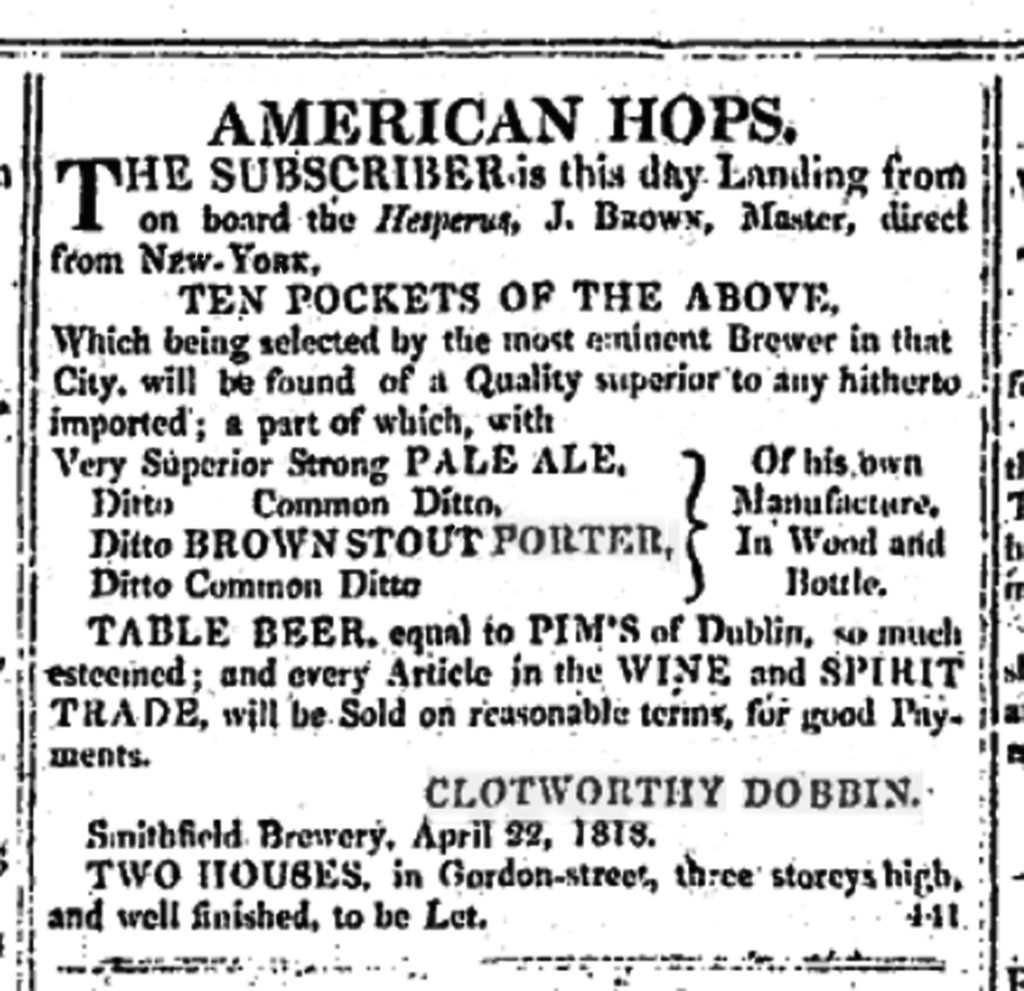 I’ve written before on how American hops were being imported to the UK in the late 1810s, after a couple of years of dreadful summer weather wrecked the English hop harvest, but this is the first time I’ve come across a specific advertisement by a brewer for American hops. This is from the Belfast Newsletter in April 1818: Belfast, of course, was a major port for the North Atlantic trade, so it was natural that hops from New York would arrive there by ships, though normally the high import tariffs then imposed on foreign hops would keep them out. Can we assume Clotworthy Dobbin was using some of those American hops in his own porter and pale ale? I think we can.
I’ve written before on how American hops were being imported to the UK in the late 1810s, after a couple of years of dreadful summer weather wrecked the English hop harvest, but this is the first time I’ve come across a specific advertisement by a brewer for American hops. This is from the Belfast Newsletter in April 1818: Belfast, of course, was a major port for the North Atlantic trade, so it was natural that hops from New York would arrive there by ships, though normally the high import tariffs then imposed on foreign hops would keep them out. Can we assume Clotworthy Dobbin was using some of those American hops in his own porter and pale ale? I think we can.
(Incidentally, I wonder if the Hesperus, the ship that, according to Dobbin’s ad, brought the hops to New York to Belfast, was the schooner whose sinking in 1839 partly inspired Henry Wadsworth Longfellow to write the poem The Wreck of the Hesperus? Hmmm …)
Dobbin’s first name, though weird-looking in the 21st century, is surprisingly common in 18th century Ulster. (There was a haberdasher’s business in Belfast in the 1790s run by Clotworthy Birnie and Clotworthy Faulkner, for example.) It comes from the surname of Sir Hugh Clotworthy of Clotworthy in Devon, High Sheriff of Antrim in the early 17th century, and more particularly Sir Hugh’s son John Clotworthy, a militant Presbyterian who, nevertheless, was on good terms with King Charles II and became the first Viscount Massereene in 1660 (Massereene being the name of an area on the eastern shores of Lough Neagh). So basically being called Clotworthy was like wearing a T-shirt shouting: “I AM A PRESBYTERIAN!”
When Dobbin entered the brewing business is a little blurry, two centuries later. He pops up in 1812 as the partner in a wine and spirits business in Hercules Street, Belfast, with John Bell, selling Cork and Dublin whiskey, Jamaican rum and Spanish red wine. Bell was also a brewer, probably from at least January 1808, when he was at 51 Hercules Lane, and advertising for a maltman “who has a perfect knowledge of his business and can be well recommended for Sobriety and Honesty,” and certainly by 1809, when he was one of four brewers to advertise in the Belfast Newsletter that they were putting up the price of their ale to 48 shillings a barrel, “in order that we may be able to make Ale of a sufficient strength to encourage its consumption, for which purpose we are now using a greater proportion of Materials in the Manufacture of that Article; and are determined to make it of such Strength and Quality as cannot fail to give general satisfaction. Table and Small-Beer to remain at the former Prices.”
In July 1813 Bell and Dobbin ended their partnership, with Bell announcing that he would be continuing to carry on the spirits business at his brewery in Hercules Street, while Dobbin had moved to new premises in North Street, where he continued to sell whiskey, rum, red wine and pickling vinegar. In December 1814, however, Dobbin formed a partnership with John Wandesford Wright to acquired the Belfast Porter Brewery in Smithfield, Belfast.
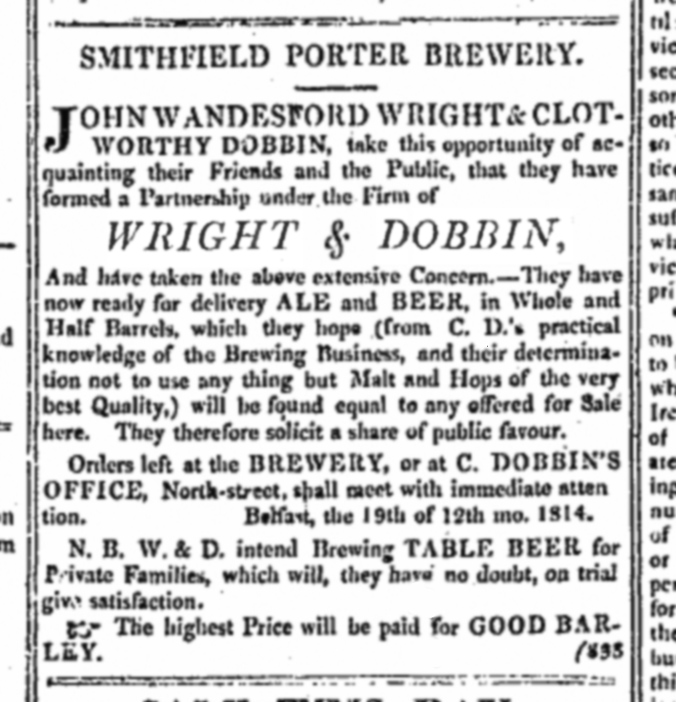 That concern looks to have been in operation by 1802, when Kennedy, Seed, Hyndman & Co were advertising that they paid the highest price for good barley at their brewery in Smithfield. It was known as the Belfast Porter Brewery by 1806, when it was being run by Forbes Anderson & Co (there had been an earlier “new Porter Brewery” in 1789 in Barrack Street, about 500 yards away, which had become a distillery by 1799). The Belfast Porter Brewery advertised regularly for barley, “for which a fair price will be given”, with, in 1809, James T Kennedy & Co of Rosemary Lane given as one of the contacts.
That concern looks to have been in operation by 1802, when Kennedy, Seed, Hyndman & Co were advertising that they paid the highest price for good barley at their brewery in Smithfield. It was known as the Belfast Porter Brewery by 1806, when it was being run by Forbes Anderson & Co (there had been an earlier “new Porter Brewery” in 1789 in Barrack Street, about 500 yards away, which had become a distillery by 1799). The Belfast Porter Brewery advertised regularly for barley, “for which a fair price will be given”, with, in 1809, James T Kennedy & Co of Rosemary Lane given as one of the contacts.
Then in February 1810 the Belfast Newsletter carried an announcement for “Dissolution of the partnership and sale of the Belfast Porter Brewery”. The announcement said the brewery was “in perfect working order and capable of turning out 6,000 barrels in the season”, and included a pale and a brown malt kiln, while the premises were “abundantly supplied with excellent Spring Water.” Would-be purchasers were told that “as the Porter heretofore made by this Company has given general satisfaction, and as the natural demand is greater than the Buildings on the Concern are at present capable of supplying, it is an object highly deserving the attention of such as may be inclined to enter into the Business more extensively, there being ground sufficient on the Premises to enlarge the Buildings to any extent.” They were also told that the current brewer, Mr Donovan, “whose knowledge of brewing Porter, and making and preparing Malt for the same, has been fully proved,” was willing to remain “for a time” with the purchasers “on proper terms”.
The Belfast Porter Brewery was advertising its porter for sale in May 1810, and “a large quantity of Pale and Brown Malt”, plus porter “delivered in Belfast, provided it is paid for in Bank Notes,” the same July. Then in the October of that year proposals were invited in writing for the brewery and all its fixtures and utensils, to be sent to James Kilbee of the Belfast Sugar House. It does not look to have sold, because it was on offer again in May 1812, including “breweries, malt houses, Etc Etc … capable of Brewing 10,000 Barrels of Porter annually, with a never-failing supply of most excellent Spring-Water,” along with “a few Bags Hops, growth 1809”, 50 barrels of porter, “remainder of the unsold”, “a large quantity of Porter Barrels and Half Barrels” and other items, “for particulars apply at the offices of Greg & Blacker or James T Kennedy & Co.” No buyer was again apparently found and the brewery was once again on sale in December 1812, with “coppers, coolers, kieves [the Irish term for a mash tun], working tuns, vatts [sic] … pale and brown malt-kilns”.
After their acquisition of the brewery in 1814, Dobbin and Wright promised the public ale and beer in barrels and half-barrels “which they hope (from CD’s practical knowledge of the Brewing Business, and their determination not to use anything but Malt and Hops of the very best Quality) will be found equal to anything offered here,” suggesting that Dobbin had been brewing alongside Bell in Hercules Street. Their advertisement in the Belfast Newsletter was dated “the 15th of 12th mo. 1814”, a clue that Wright, at least, was a Quaker, since not using the names of the days or months was a practice of the Society of Friends.
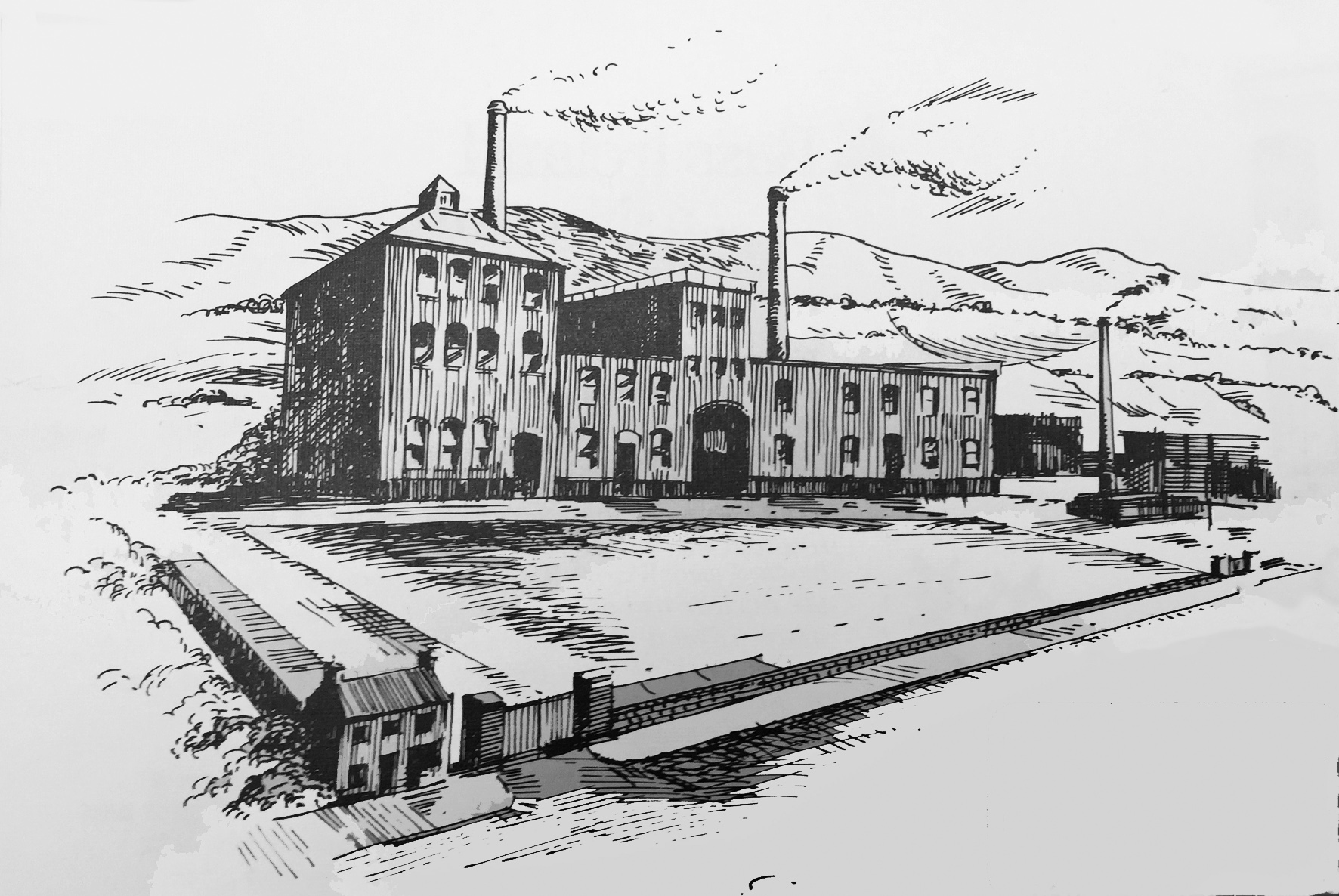
Not quite 18 months later, in May 1816 Wright and Dobbin announced the end of their own partnership, with Dobbin declaring that he would be continuing on his own as a brewer of double brown stout porter, common porter, strong ale and table beer. Before the partnership broke up, there had been a fire at the brewery which resulted in a claim of £1,840 against the Atlas insurance Company – equivalent to perhaps £1.4 million today. The insurance company refused to pay, claiming that the premium had not been paid, and the case went as far as the High Court in Dublin before the insurers handed over the money.
Dobbin’s business went through a dodgy patch in the early 1830s which saw him insolvent at one point, but he pulled everything together and eventually paid off all his creditors at 20 shillings to the pound, plus interest – a performance which earned him the presentation of a valuable set of silver plate from several English finance houses with whom he had done business, and a thank-you dinner in December 1835 attended by 80 Belfast merchants and dignitaries.
What sort of employer Dobbin was we may be able to tell from the fate of one of his unfortunate draymen, James McFerran, who was fined six shillings plus costs at Belfast Police Court in July 1852 after being found guilty of desecration of the Sabbath, for collecting beer barrels with a horse and dray on a Sunday evening. In mitigation, McFerran told the court that he could not collect as many barrels on a Saturday evening as would be required on a Monday morning, and he was “afraid of losing his situation, as Mr Dobbin was out of town, and he had no person to get directions from.”
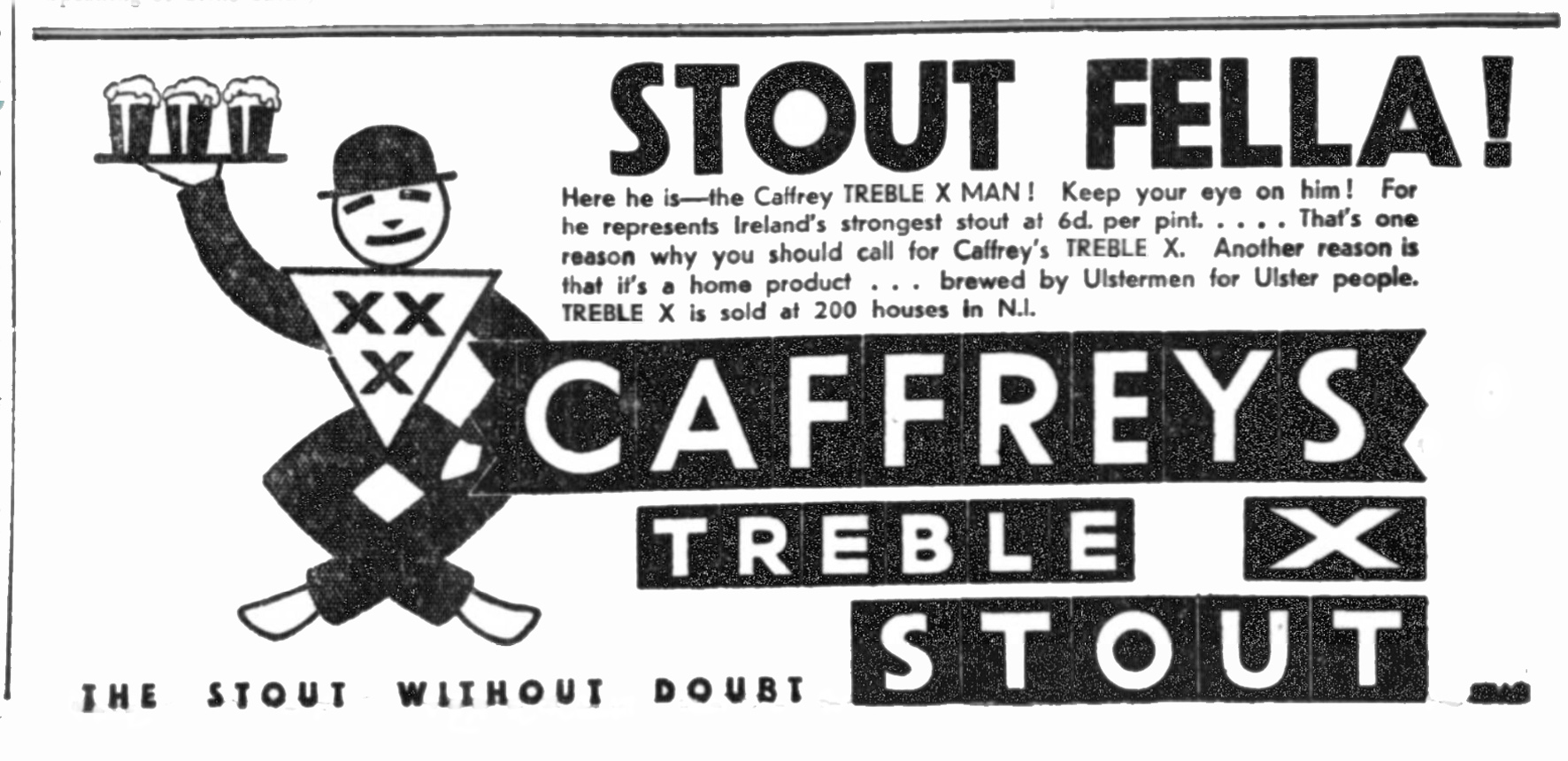 The brewery in Smithfield eventually passed to Dobbin’s son-in-law Thomas Caffrey, a Dubliner. In 1897 Caffrey began moving operations to a new brewery on the Glen Road in Andersonstown, west Belfast, which opened officially in 1901 as the Mountain Brewery. After Caffrey’s death the concern was run by his son, and then by his grandson. In the 1920s it defended itself against rivals by boasting that its Treble X stout was the “strongest stout brewed in Ireland” (not strictly true, since Guinness FES was a lot stronger, but that wasn’t sold in Ireland at the time) and pitching itself as the price-conscious pint, at 6d (six pence) a pop. For the even more price-conscious it sold a stout called “Caffrey’s 4d Pint”, which was knocked on the head when the Second World War started and rises in the tax on beer in the UK made it impossible to brew a stout that could be sold for 4d. The brewery also played on local loyalties, declaring that its beer was “brewed by Ulstermen for Ulster people”, and inventing a little bowler-hatted Ulsterman character called “Mr Treble X”.
The brewery in Smithfield eventually passed to Dobbin’s son-in-law Thomas Caffrey, a Dubliner. In 1897 Caffrey began moving operations to a new brewery on the Glen Road in Andersonstown, west Belfast, which opened officially in 1901 as the Mountain Brewery. After Caffrey’s death the concern was run by his son, and then by his grandson. In the 1920s it defended itself against rivals by boasting that its Treble X stout was the “strongest stout brewed in Ireland” (not strictly true, since Guinness FES was a lot stronger, but that wasn’t sold in Ireland at the time) and pitching itself as the price-conscious pint, at 6d (six pence) a pop. For the even more price-conscious it sold a stout called “Caffrey’s 4d Pint”, which was knocked on the head when the Second World War started and rises in the tax on beer in the UK made it impossible to brew a stout that could be sold for 4d. The brewery also played on local loyalties, declaring that its beer was “brewed by Ulstermen for Ulster people”, and inventing a little bowler-hatted Ulsterman character called “Mr Treble X”.
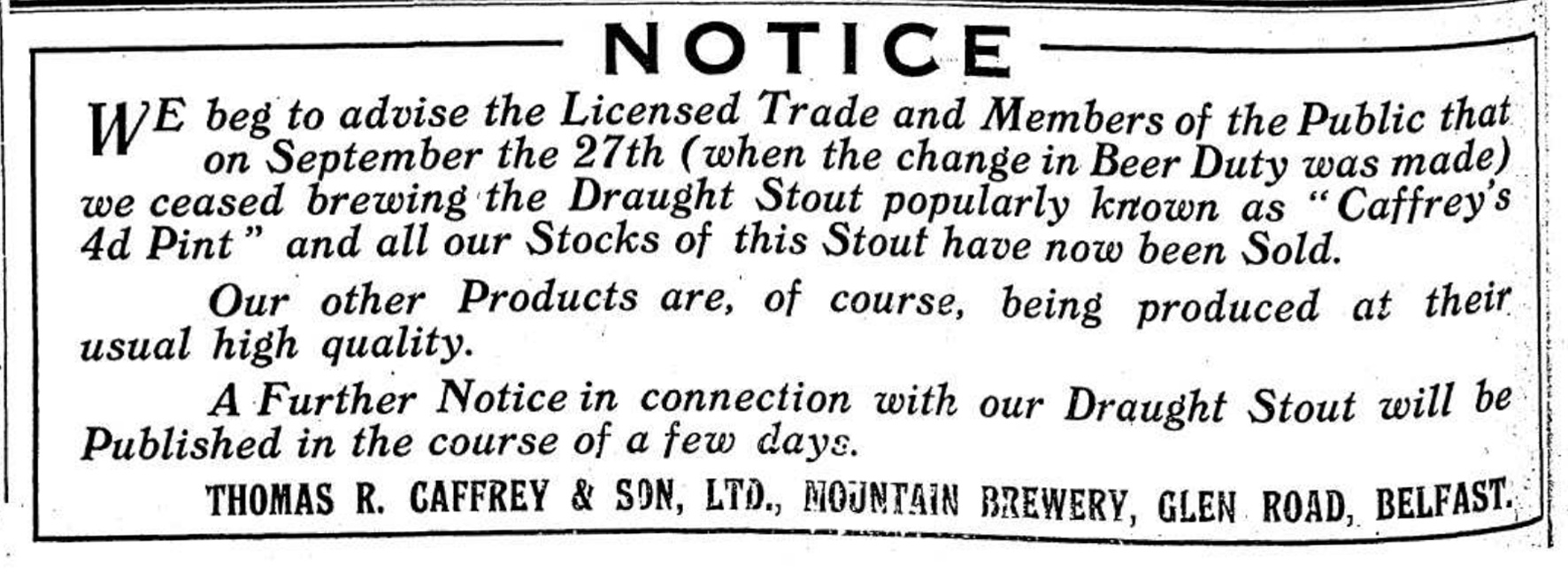
Caffrey’s finally went under in 1950, but stayed shuttered for only four months before being acquired by a consortium of Ulster-based pub owners and reopened as the Ulster Brewery Company. In October 1960 the Ulster Brewery Co agreed to be taken over by Northern Breweries, the growing empire put together by the Canadian entrepreneur Eddie Taylor to provide outlets for his Carling Black Label lager in the UK, though by the time the deal was completed Northern Breweries had become United Breweries. United merged with Charringtons of East London in April 1962 to form Charrington United Breweries, and two months later work started on a new brewery in West Belfast, built in front of the old one, at a cost of £500,000 , which opened in November 1962. Charrington United then merged with Bass, Mitchells & Butlers in July 1967 to form Bass Charrington.
The Ulster brewery remained part of Bass, and in 1994 it was used as the base to roll out a new “nitrogen-serve” or “smoothflow” keg bitter under the Caffrey’s name. Caffrey’s ale was hugely successful when it first launched, with 150,000 barrels sold in its opening year. Then, in 2000, Bass sold all its brewery holdings to Interbrew. Since the Belgian giant already owned Whitbread, Interbrew was forced by the British government, after Competition Commission inquiries and court cases, to sell most of the former Bass empire, including the Caffrey’s brand. But it kept hold of the Ulster brewery (and the Bass brand, which it has subsequently managed to royally screw up). However, the loss by the Ulster brewery of a €9 million contract to bottle Lucozade, of all things, led Interbrew in August 2004 to decide to shut down the Belfast operation, after failing to find a brewer, and it closed the following year.
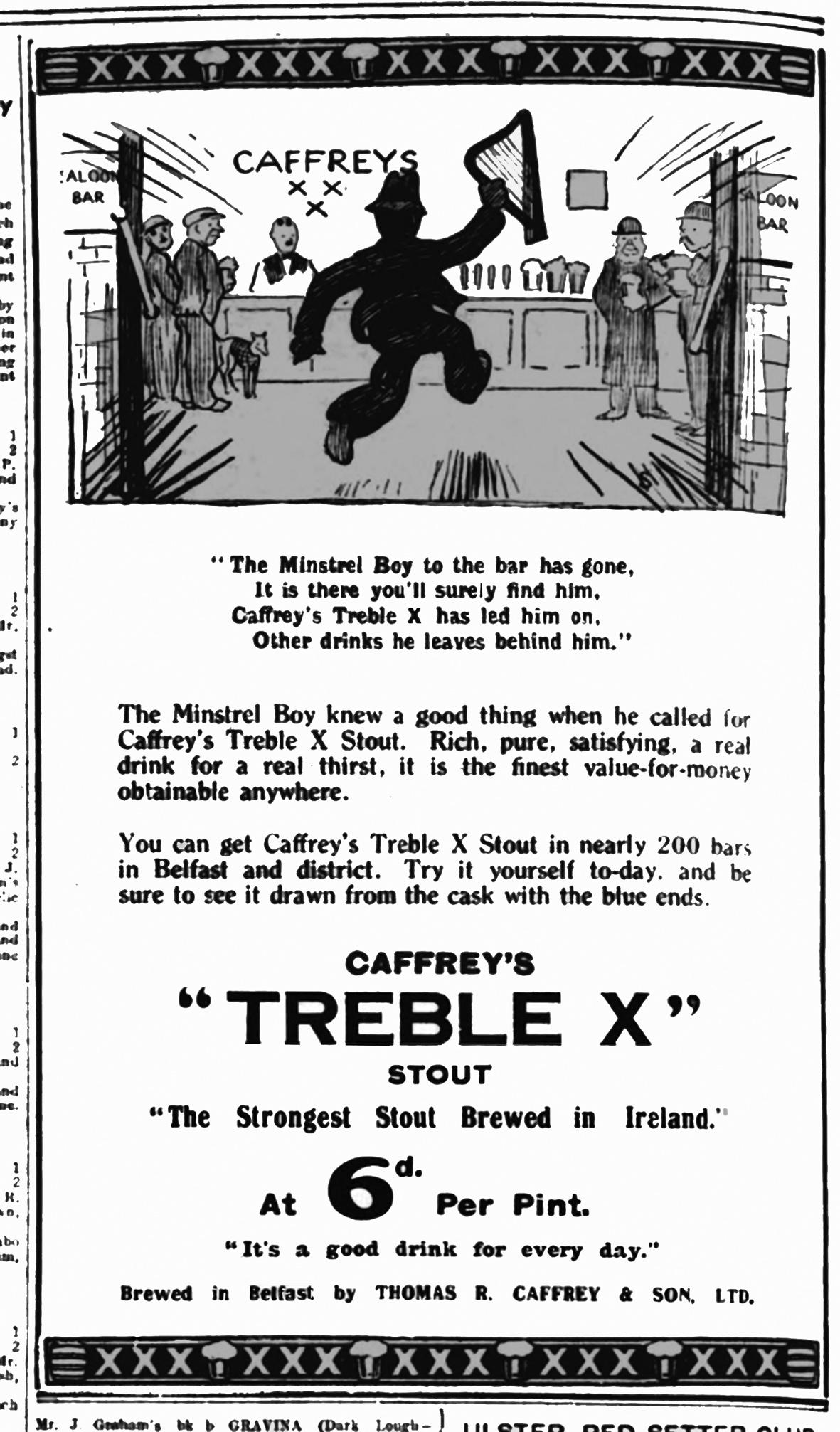

Great article containing the earliest direct reference to an actual brewery I’ve seen but there are articles showing that American hops were imported into the UK from Boston via Ireland, even earlier, in the late 1700s. As I can’t paste copies of the adverts here (if you email me I will send copies)- some of the earliest references which can be viewed on the British Newspaper Archive site are: Kentish Weekly 07 Jan 1794 (pg 4); Saunders News-Letter 06 July 1795 (pg 3) and the one in the same paper 15 Feb 1803 (Pg 2) states as part of the ad : “The strength of the American Hop is now known to be superior to that of other growths, and its flavour to be particularly adapted for making the best Porter”
Very interesting … I’ve emailed you
I was waiting for Brendan D. to make an appearance. Any relation (claimed or actual) of Clotworthy, I wonder.
It would seem that Holland beat the English to it: in 1803, a company of eight brokers announced the sale of excellent new ‘Amerikaansche hop’, on the 6th of April in an inn called De Pool in Rotterdam.
Mmmm, but did they beat the Irish?
Apparently not, if they were already at in in 1794 🙂
Worth noting that Whitewater Brewery has for a long period produced an excellent ale named Clotworthy Dobbin